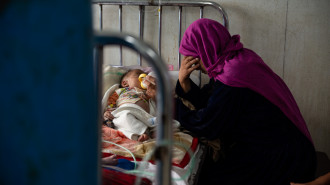
ShareFlipboardRedditWhatsAppTwitterFacebook
The number of dangerously malnourished children in Afghanistan has increased by 47% since January this year, with some babies dying before managing to receive any treatment, a children’s charity has said.
Demand for malnutrition treatment services has surged in recent months as families struggle to cope with Afghanistan’s worst hunger crisis on record, according to Save the Children.
Experts had hoped to see a drop in hunger levels in Afghanistan during the recent summer harvest season, but the ongoing drought has led to failed crops and harvests have been much smaller than normal, forcing many rural families to sell land and livestock to buy food to feed their children.
“The needs are so high that 50% of Afghanistan’s population is still facing extreme hunger, with six million children and adults – nearly one eighth of the population – one step away from famine”
The other major driver of the food crisis – the collapse of the country’s economy – has caused unemployment, poverty and food prices to skyrocket, with many families now only surviving on bread and water for weeks at a time.
Humanitarian organisations have provided vast amounts of life-saving food, but the needs are so high that 50% of Afghanistan’s population is still facing extreme hunger, with six million children and adults – nearly one-eighth of the population – one step away from famine.
Save the Children doctors say they are overwhelmed with malnourished children – especially young girls who are often deprioritised when it comes to breastfeeding and complementary feeding compared to boys – and cannot keep up with the demand for services.
While Nelab’s son Mohammad*, 2, has recovered, her other daughter, Parsto*, who is just 11 months old, is still dangerously malnourished.
“Every day we’re faced with the heart-wrenching decision – which children do we save?”
Nelab said: “There has been less rain than usual so if we plant something it doesn’t grow and then that makes the food really expensive. When there’s no food, the children go hungry or we borrow money. Sometimes we only cook one meal a week. That meal is a soup without meat.
“In between, we eat bread one to two times a day. The situation is much worse than a few years ago. It makes me sad to know my children are malnourished because we don’t have anything to eat, and I don’t know how I can make them better,” she added.
The foreign aid which once propped up the country has been slow to return, with the hardline Islamists also cut off from Afghan assets held abroad.
“Every day we’re faced with the heart-wrenching decision – which children do we save?” said Save the Children’s Country Director in Afghanistan, Chris Nyamandi. “It’s outrageous and horrifying to think that international leaders have the power to save these children’s lives – by working to solve the economic crisis and reinstating humanitarian funding and long-term development assistance that was withdrawn when the Taliban retook control – but they have been too slow to find solutions and now children are dying as a result.
“Humanitarian organisations have been sounding the alarm on Afghanistan for more than a year now. It’s time the world stopped ignoring this catastrophic crisis and took action before many more children lose their lives,” Chris concluded.
The article appeared in the the New Arab.
